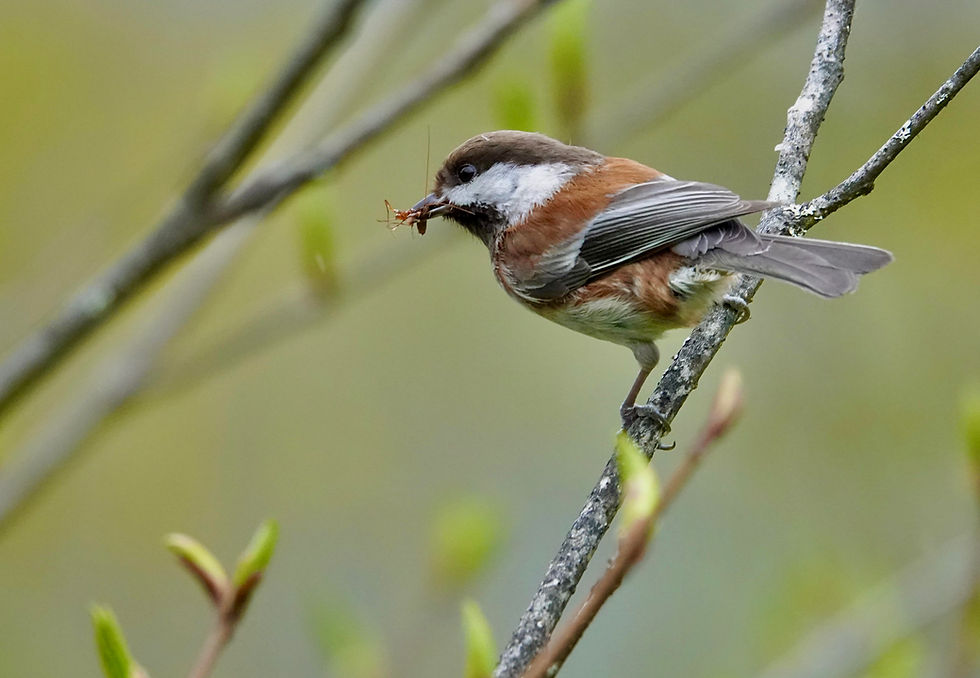On The Trails: Chickadees
- Mary F. Willson

- Oct 19
- 3 min read

By Mary F. Willson
They’re fun to watch — always active, leading mixed species flocks in fall, sometimes storing seeds for hard times to come.
Right now, as I write this, the mixed-seed feeder hanging over my pond is thronged with busy chestnut-backed chickadees, taking sunflower seeds. Without obvious aggressive interactions, they alternate their use of the feeder: four at a time (one at each portal in the feeder), with others coming in from the trees nearby or from the peanut butter feeder or the suet.
Flitting back and forth…they are so busy, it’s impossible to keep track of all of them. But by paying very close attention, I am quite sure that there are at least eight in this aggregation. Upon occasion, they make way for those pushy blue gluttons called jays. Sometimes a nuthatch takes advantage of a brief lull in the chickadee flurry. Juncos may come in for millet seed when other activity lapses. But recently it’s been a chickadee show.
Worldwide, there are 15 species of chickadees in the genus Poecile (by current taxonomy). Most of them live in Eurasia; seven species live in North America.
Here in Alaska we have four resident chickadee species. Our familiar chestnut-backed chickadee ranges in coastal forests from southern Alaska to mid-California, with some inland populations in the Pacific Northwest and adjacent parts of Canada and in northern California. The gray-headed chickadee occurs in Eurasian forests, where it has been well-studied, but it also occurs in central Alaska (and a bit of northwestern Canada), where it has become very rare. The boreal chickadee ranges from Alaska all the way to the East Coast, mostly in Canada. The black-capped chickadee has the widest range of all: over the northern tier of states and much of southern Canada, from Interior Alaska to the east coast.
Sometimes we get strays from other species. Mountain chickadees live in montane forests, ranging from southern Yukon to Arizona. A mountain chickadee was reported recently from the dike trail, drawing a crowd of birders and photographers.

There are two more North American species: The Mexican chickadee lives in montane forests of Mexico, sometimes just crossing the border into the U.S. The Carolina chickadee resides in the eastern forests, from New Jersey west to Kansas and south to the Gulf coast.
Hybrids can occur wherever two species’ ranges overlap, especially in areas disturbed by humans. Because hybrids can back-cross with either parent species, the genetic "border" between species is not strictly maintained. However, the distinctions between species have apparently remained.
I’m willing to bet that my chestnut-backed visitors store some of those sunflower seeds from my feeder. Most kinds of chickadees cache seeds. Chickadees don’t pile up their seeds in one place, as red squirrels often do with spruce cones. Instead, they scatter-hoard, tucking seeds into various nooks and crannies — under bark, in knotholes, in clusters of leaves, sometimes in human structures--and somehow remembering where to find them again. That becomes possible because the part of their brain concerned with spatial memory enlarges in fall.
All those hidden sunflower seeds are subject to thievery by other seed-eaters, such as nuthatches or other chickadees or even squirrels. Although the stored seeds are usually spread out, not concentrated in one easy-to-raid area, theft is always a risk. To some extent, thievery can be reduced making dummy hoards…appearing to stash a seed but flitting off to put it somewhere else. Such evasive behavior may depend on what potential seed thieves might be observing; a critter that seldom eats seeds may be ignored.
We’ve been wondering if our chickadees also store their lumps of peanut butter; sometimes we see behavior that suggests this — a chickadee with some peanut butter, poking into the top of a beam on the deck. But I wonder if that would be a sound strategy. The delectable aroma might attract potential thieves, at least for a while. And the oils probably soak into the wood and maybe the bark, reducing the food value of the stored sample. More information needed!
• Mary F. Willson is a retired professor of ecology. "On The Trails" appears periodically in the Juneau Independent.












